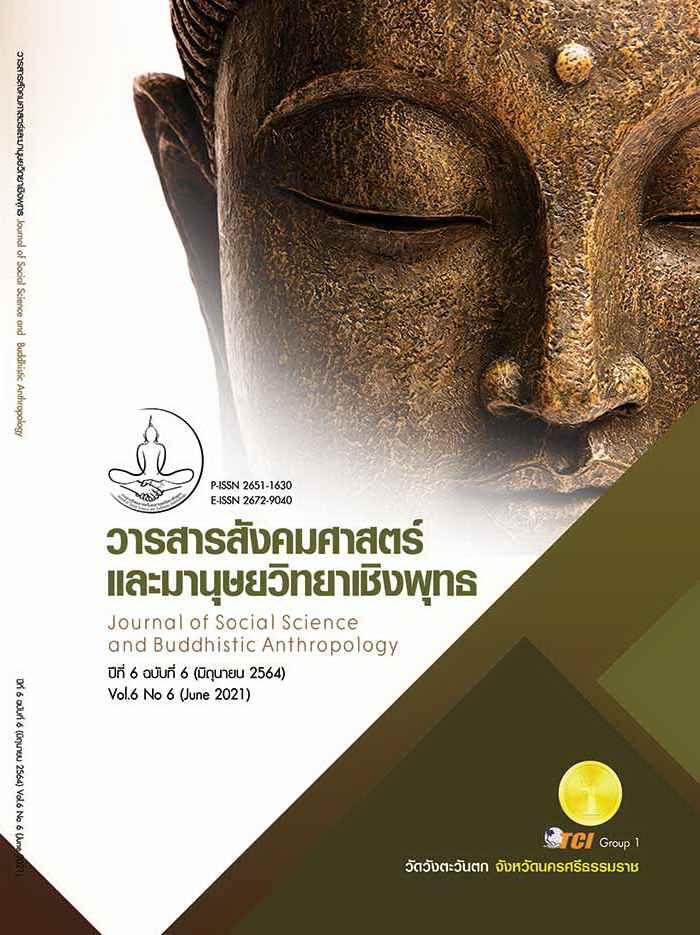THE DEVELOPMENT OF VIRTUAL REALITY AS A NEW BUDDHISM LEARNING MEDIUM
Keywords:
The Development of Virtual Reality, Tool for New Media, Learning BuddhismAbstract
The objectives of this research article were to: 1) study and analyze perception theory, learning theory, narratology, and levels of user interaction in Virtual Reality, 2) develop a paradigm to develop learning tools and create Virtual Reality new media art as Buddhist learning tools, and 3) study the efficiency of the virtual reality learning tools. This research is mixed-method research. Qualitative research methodology was used to develop the virtual reality Buddhist learning tools. Quantitative research methodology was employed to validate the results. A total of 10 experts in related fields were consulted. Quantitative samples were collected and analyzed from 107 exhibition visitors. The data analysis used mean and standard deviation. The findings of the research showed that 1) Virtual Reality is a suitable learning medium as it uses sight and hearing which are the two of the most important perception methods for humans. It’s also able to tell the story in first-person mode which is highly effective. 2) The researchers developed a paradigm of creation and created Virtual Reality learning tools on the subject of Enlightenment, and 3) Qualitative analysis shows that the experts are in concord regarding the effectiveness of VR as a Buddhist learning tool. Quantitative analysis reveals that Virtual Reality is an effective learning tool that enables users to gain knowledge through user engagements. This research reaffirms that Virtual Reality is an efficient medium to create Virtual Reality Buddhist learning tools and pass on the faith of Buddhism.
References
จิรัฐ เจนพึ่งพร และคณะ. (2560). ธนาคารแห่งประเทศไทย: ประเด็นชวนคิด 6 Mega trends กับเศรษฐกิจไทย. เรียกใช้เมื่อ 11 กันยายน 2562 จาก https://www.bot.or.th/Thai /ResearchAndPublications/DocLib_/Article_14Sep2017.pdf
เติมศักดิ์ คทวณิช. (2546). จิตวิทยาทั่วไป. กรุงเทพมหานคร: ซีเอ็ดยูเคชั่น.
พระไพศาล วิสาโล. (2553). ศิลปะกับพุทธศาสนา. เรียกใช้เมื่อ 14 กรกฎาคม 2561 จาก https://www.visalo.org/article/PosttoDay255308.html
Baukal, C. et al. (2013). A Proposed Multimedia Cone of Abstraction: Updating a Classic Instructional Design Theory. i-manager’s Journal of Educational Technology, 9(4), 15-24.
Cronbach, L. J. (1990). Essentials of psychological testing (5th ed.). New York: Harper Collins Publishers.
Harris, B. J. (2020). The history of the future Oculus Facebook and the revolution that swept virtual reality. New York: Dey Street.
Jahn, M. (2017). Narratology: A Guide to the Theory of Narrative. In English Department. University of Cologne.
Kandel, E. R. et al. (2000). Principles of neural science. New York: Elsevier.
Karnchanapayapayap, G. . (2019). VR Animation: The New Transformation of Storytelling. Osaka: Japan.
Lee, S. J. & Reeves, T. C. (2007). Edgar Dale: A significant contributor to the field of educational technology. Educational Technology, 47(6), 56-5.
Payatagool, C. (2008). Theory and Research in HCI: Morton Heilig, Pioneer in Virtual Reality Research. Retrieved January 29 , 2563, from http://www.telep resenceoptions.com/2008/09/theory_and_research_in_hci_mor/
Tharp, K. (2019). Virtually Tilted: An Exhibition of Tilt Brush Artistry. Retrieved October 13, 2563, from http://virtuallytilted.kevinwtharp.com/
Wagner, R. (1970). Edgar Dale: Professional. Theory Into Practice, 9(2), 89-95.








